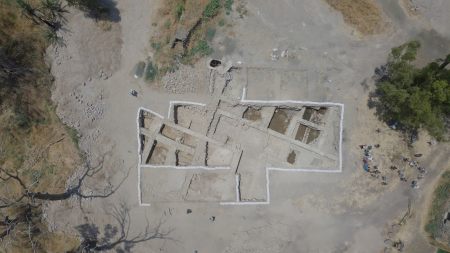Ancient biblical Church of the Apostles discovered near Sea of Galilee, archaeologists say

Archaeologists believe they have likely found the Church of the Apostles, which is said to have been built over the house of Jesus’ disciples Peter and Andrew in the ancient Israeli city of Bethsaida, near Israel’s Sea of Galilee.
The biblical discovery was made by a team from Kinneret College in Israel and Nyack College's Center for the Study of Ancient Judaism and Christian Origins, who have been excavating the site of el-Araj on the northern shore of the Sea of Galilee since 2017.
Archaeologists believe that el-Araj is the site of the ancient Jewish fishing village of Bethsaida, which later became the Roman city of Julias.
Previously, the group had uncovered evidence of the church’s existence, such as reliquary that once could have held the remains of the Apostles Philip, Andrew and Peter, pieces of marble from its chancel screen, and small gilded glass blocks called tesserae that were used in ornate church wall mosaics.
Now, archaeologists have announced they discovered the church’s ornate mosaic floors, parts of which are well-preserved, Fox News reports.
“These discoveries already informed us that the church was waiting to be found somewhere nearby,” professor Steven Notley of Nyack College, told Fox News. “It is always remarkable to bring these beautifully decorated floors to light after being buried for almost 1,500 years."
The professor said the discovery of the church is significant, as many scholars had questioned its existence.
“Although it is mentioned in Byzantine pilgrimage itineraries, many thought these reports mistaken,” Notley said. “Of equal importance, the church indicates that there existed a living memory in the Christian community about the location of Bethsaida, home of Peter and Andrew and Philip (John 1:44),” he said.
According to historians, Bavarian bishop and saint Willibald visited the area around 725 AD and reported that a church at Bethsaida had been built on the site of Peter and Andrew’s home, as described in the New Testament. Bethsaida is also the location where Jesus healed a blind man, according to Mark 8:22-26, while Luke 9:10-17 describes a nearby location for the feeding of the 5,000 people.
Notley said the discovery of the church reinforces the team’s belief that el-Araj is indeed ancient Bethsaida.
Another archaeologist from the team, professor Mordechai Aviam, said the church seems to have been built in the fifth century, about 500 years after the apostles would have lived. It was abandoned in the late seventh century.
“We excavated only one third of the church, a bit less, but we have a church and that’s for sure,” Aviam told AFP. “The plan is of a church, the dates are Byzantine, the mosaic floors are typical … chancel screens, everything that is typical of a church.”
“Between Capernaum and Kursi there is only one place where a church is described by the visitor in the eighth century and we discovered it, so this is the one,” he said.
The team also uncovered a Roman period house from the main excavation site, leading experts to believe that the ancient Jewish village, which was re-founded by the Jewish tetrarch Herod Philip as a polis and re-named Julias, had spread over a very large area. Archaeologists found typical Jewish stone vessels and Jewish oil-lamps and over 20 Roman-period coins and fishing lead weights there.
Notley told Israeli daily newspaper Haaretz that while archaeologists are confident in their discovery, the identification of the church cannot be entirely proven unless an inscription is found.
“It would be normal to find an inscription in a church of the Byzantine period, describing in whose memory it was built, for instance,” he says.
Still, he told Fox News that he believes the next excavation season at el-Araj will reveal more of the ancient site, adding the team plans to entirely excavate the Byzantine church.
“Thus far, we have only uncovered some of the southern rooms of the church, likely the southern aisle,” Notley said. “At the end of this season, we were just beginning to uncover the mosaics of what is likely the nave, the center section of the church.”






















